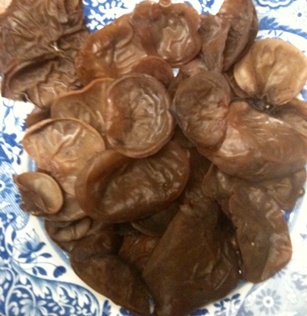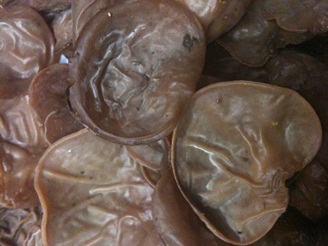Miss Thrifty3 November 11, 2011
 So the new guy who sits opposite me at work turns out to be a Wild Man of the Woods. Well, not quite, but close… His name is Rob and with his friend Leo, he has co-authored a book about the simple pleasures of reconnecting with Nature. It comes out in Spring 2012, and includes everything from skimming stones to building woodland dens.
So the new guy who sits opposite me at work turns out to be a Wild Man of the Woods. Well, not quite, but close… His name is Rob and with his friend Leo, he has co-authored a book about the simple pleasures of reconnecting with Nature. It comes out in Spring 2012, and includes everything from skimming stones to building woodland dens.
When Rob told me about the food he forages in the woods on his morning runs, my ears pricked up. Partly because I thought he could write a great post about it. (And partly, I must admit, because to a heavily pregnant person the concepts of jogging and eating food that doesn’t come with a best before date seem unfeasibly exotic and daring. Ah, not long to go now!)
We agreed to swap a post for a book plug, so here is the story of what Rob did the other week when he chanced upon some Jelly Ear fungus growing on an elder log…
You can’t get much more thrifty than free food and, although it may take getting some used to, swapping the supermarket aisle for the hedgerow every now and then can provide some real bargains.
Few hungry diners would think twice about ordering wild mussels at a restaurant, yet how many of those same diners would feel confident plucking them from the shore themselves? Despite the epithet wild being sprinkled over menus in increasingly liberal portions, most people still approach foraging for food with some trepidation. And for good reason. The risk of accidentally picking poisonous berries or potentially fatal fungi when there is such an abundance of cheap pre-packaged convenience food around might seem a foolish waste of effort and an unnecessary gamble.
Strange then, that we still let our children pick and eat blackberries straight from the bramble. Ah… but that’s different. Or is it? Alongside hedgerow blackberries there may be very different blackberries which have a horribly destructive effect: deadly nightshade, for example. No, it is because we are so familiar with the blackberry’s shape, we know how they grow, where they grow and can point them out that puts us at ease. It’s the same with all wild foods: amateur foraging is just a case of getting your eye in.
I went for a run through the woods near my new house last weekend, giving my body a workout before a weekend of entertaining friends. The recipe for the fish pie I was to cook that night was also running through my mind, the sustainable coley and mussels expertly foraged from the supermarket reduced aisle in true thrifty spirit.
 What to do for a starter though? Something cheap, warming, homely and ideally local… Then I saw them lying like a brown seam along a trunk of fallen elder: nature’s answer to my appetiser conundrum.
What to do for a starter though? Something cheap, warming, homely and ideally local… Then I saw them lying like a brown seam along a trunk of fallen elder: nature’s answer to my appetiser conundrum.
Jelly Ear fungus is possibly the most unpleasant fungus to stumble upon; yet like many wild foods, what it lacks in beauty, it more than makes up for in personality. The cold, soft, velvety texture is uncannily like an ear and is always a source of intrigue, passed around friends with exclamations of delight and disgust. Most abundant in summer and autumn, it can be found widespread around the UK during all seasons, only it is liable to be dried up and tougher in winter. A simple soaking in water for an hour will restore it to its supple, if ugly, form.
Strange looking it may be, but you shouldn’t judge a book by its cover. Jelly Ear is as valuable as it is unmistakable because when it comes to edible fungi, easy identification is probably the most redeeming quality. In the east, Jelly Ear (known as Wood Ear in China and Japan) is much prized for its medicinal benefits. Hailed as an anti-inflammatory, it is eaten to relieve tonsillitis, swelling, etc, but is also becoming regarded as a powerful anti-carcinogen, used to prevent, treat and stop tumours.
In the West, the influx of Eastern restaurants – Thai in particular – means that you have probably eaten it before, though you may not have recognised it. Chains like Wagamama and Busaba Eathai cook with the fungi in their Tom Yum and hot and sour soups, whereupon it takes on a black, glossy nature.
Jelly Ear grows predominantly at right angles on dead elder. It looks and feels almost exactly like a brown human ear, cold to the touch and fleshy. With no stem, the ‘ears’ will be different sizes, some small and firm; the older, larger, flatter specimens as large as a hand and flappy.
I set about picking along the trunk, choosing the medium and smaller examples for their firmer flesh. My hands became dirty as I picked amongst the mossy flank and filled my pockets, but the mud was a small price to pay. I soon felt a sense of closeness with the woodland around me, a place I had only just discovered.
Just by stopping and looking, myriad other sounds and sights revealed themselves: a woodpigeon and blue tit vying for the same airspace; from up a slope the shadow of a larger animal in the leaves, a fox perhaps or a rabbit, soft-padding down a run. These were things I would have missed if merely running through the trees. Just as with blackberry picking, there is a wider sense of oneness with the terrain when you forage for food. You can’t help but feel more rooted to the landscape.
That evening, with friends huddled round the stove and fish pie in the oven, I made up my starter. The Jelly Ear was washed, cut into thick strips and sitting in a bowl as I finely chopped a green chilli and garlic clove and turned them in a melted mix of butter and rapeseed oil. A few seconds later, the fungi was in the pan and I stirred it in the heat as it changed from dark brown and eventually into black. In went a half a litre of boiling water and a vegetable stock cube and I flaked in a quarter of a chicken stock cube, adding more chilli and black pepper to taste.
At first people were reticent, suspicious of the black strips of mushroom in their bowl. I explained it was the same fungi found in Wagamama’s and all recognised it with exclamations of “aaaah” and, “I knew I’d seen it before”. One spoonful was all it took to convert them and, as they slurped down the translucent broth rich with a thick mushroom flavour and warming chilli kick, I told them the tale of finding the Jelly Ear. Free food and a good story, a priceless reward for a morning run.
‘Skimming Stones and Other Ways of Being in the Wild’ by Rob Cowen and Leo Critchley (Coronet, February 2012 – available to pre-order from Amazon) is a book of simple skills that can help us to interact with nature, achieve a deeper connection with it and even step inside another dimension.
Learn to make and fly a kite, make an elder whistle, dam a stream and more… The book’s techniques are intended to be not only of practical value but also techniques for meditation. They help us to live in the moment, recover ancient insights and rhythms and encourage nature to reveal to us her secrets and treasures.
3 Responses to “Foraging for Jelly Ear fungus”
maria says:
lovely post and reminded me a lot about my childhood. thanks for posting.
November 14, 2011 at 2:52 pm
Rob Cowen says:
Thank you Maria. If you’d like to see more childlike wonder in action, see us building a den here: http://www.robandleo.com/pages/build-a-shelter-video – enjoy!
November 14, 2011 at 3:41 pm